Lawson: Cycle 3 “Wash Me Away and Birth Me Again”
Posted: December 14, 2023 Filed under: Nico Lawson, Uncategorized | Tags: Au23, Cycle 3, dance, Digital Performance, Isadora Leave a comment »Changes to the Physical Set Up
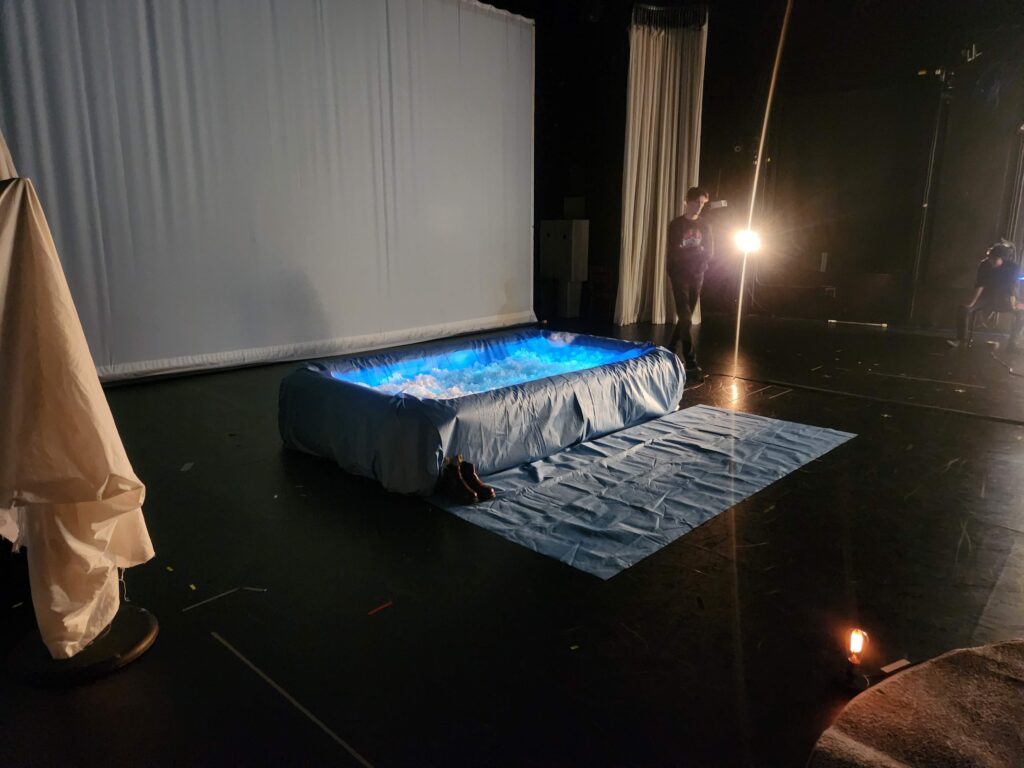
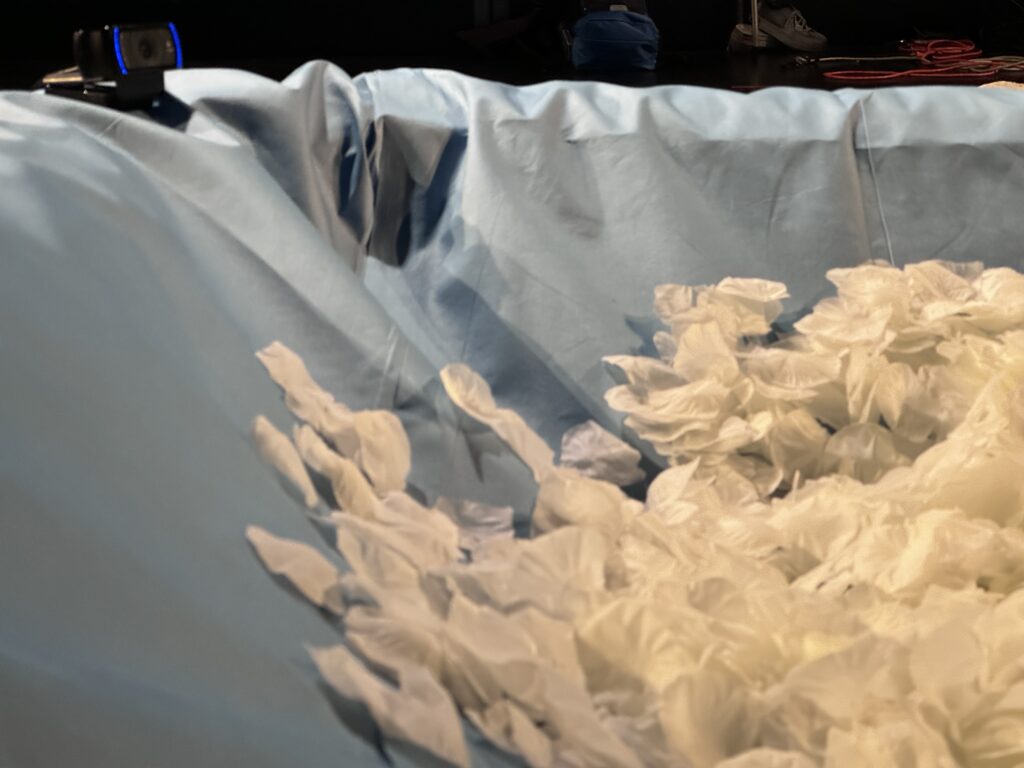
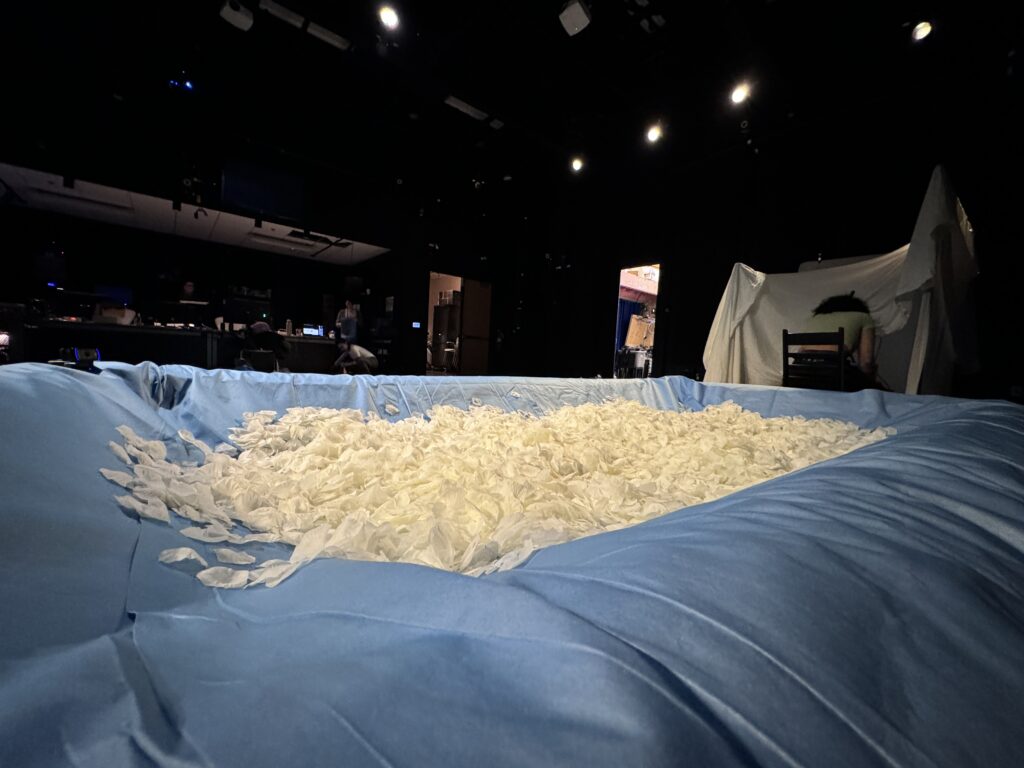
For cycle 3, knowing that I wanted to encourage people to physically engage with my installation, I replaced the bunched up canvas drop cloths with a 6 ft x 10 ft inflatable pool. I built up the bottom of pool with two folded wrestling mats. Building up the bottom of the pool made the pool more stable and reduced the volume of silk rose petals that I would need to fill the pool. Additionally, I wrapped the pool with a layer of blue drop cloths. This reduced the kitschy or flimsy look of the pool, increased the contrast of the rose petals, and allowed the blue of the projection to “feather” at the edges to make the water projection appear more realistic. To further encourage the audience to physically engage with the pool, I placed an extra strip of drop cloth on one side of the pool and set my own shoes on the mat as a visual indicator of how people should engage: take your shoes off and get in. This also served as a location to brush the rose petals off of your clothes if they stuck to you.
In addition to the pool, I also made slight adjustments to the lighting of the installation. I tilted and shutter cut three mid, incandescent lights. One light bounced off of the petals. Because the petals were asymmetrically mounded, this light gave the petals a wave like appearance as the animation moved over top of them. The other two shins were shutter cut just above the pool to light the participant’s body from stage left and stage right.
Changes to the Isadora Patch
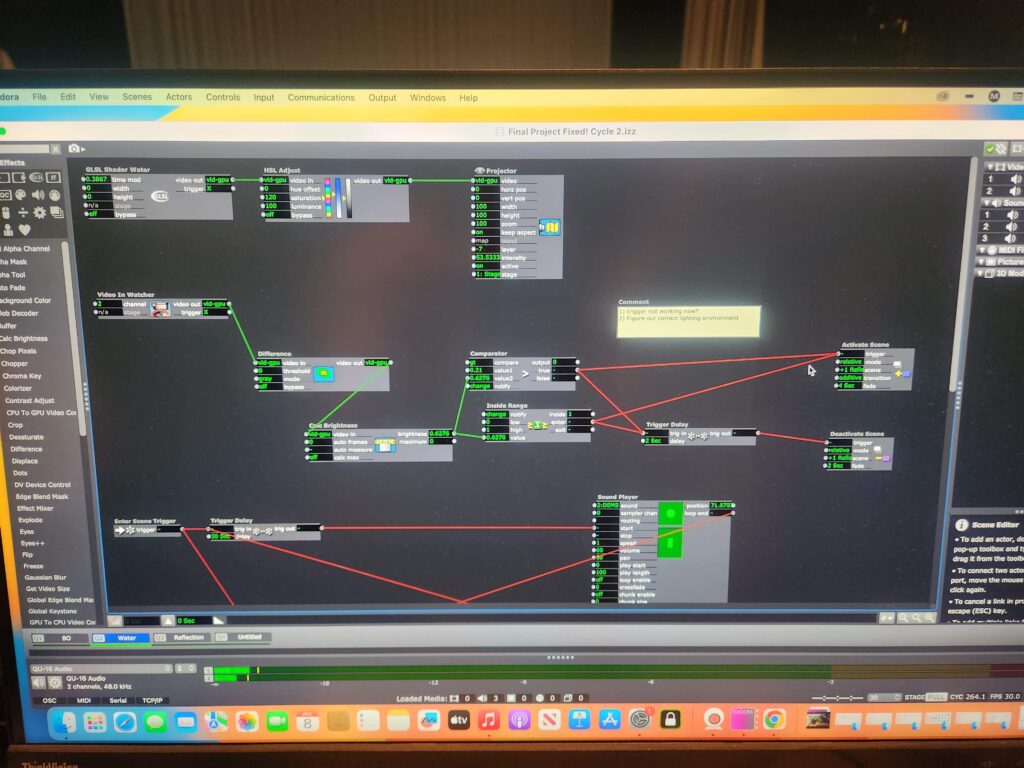
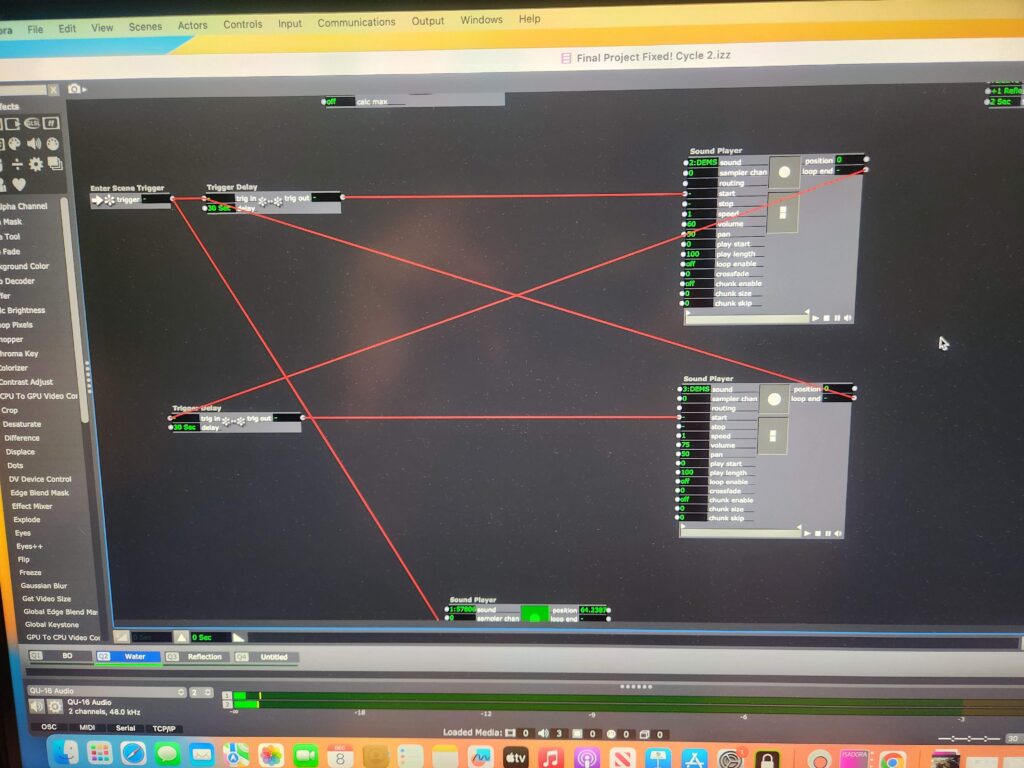

During cycle 2, it was suggested that I add auditory elements to my project to support participant engagement with the installation. For this cycle, I added 3 elements to my project: a recording of running water, a recording of the poem that I read live during cycle 2, and a recording of an invitation to the audience.
The words of the poem can be found in my cycle 2 post.
The invitation:
“Welcome in. Take a rest. What can you release? What can the water carry away?”
I set the water recording to play upon opening the patch and to continue to run as long as the patch was open. I set the recordings of the poem and the invitation to alternate continuously with a 30 second pause between each loop.
Additionally, I made changes to the reflection scene of the patch. First, I re-designed the reflection. Rather than using the rotation feature of the projection to rotate the projected image from the webcam, I used the spinner actor and then zoomed in the projection map so it would fit into the pool. Rather than try to make the image hyper-realistic, I decided to amplify the distortion of the reflection by desaturating it and then using a colorizer actor to give the edges of the moving image a purple hue. I also made minor adjustments to the motion blur to play up the ghostliness of the emmanation.
Second, I sped up the trigger delay to 3 seconds and the deactivate scene trigger to 2 seconds. I made this change as a result of feedback from a peer that assisted me with my adjustments to the projection mapping. She stated that because the length of time of the fading up and down of reflection scene took so long to turn on and off and the reflection itself was so subtle that it was difficult to determine how her presence in the pool was triggering any change. I found the ghostliness of the final reflection to be incredibly satisfying.
Impact of Motion Lab Set Up
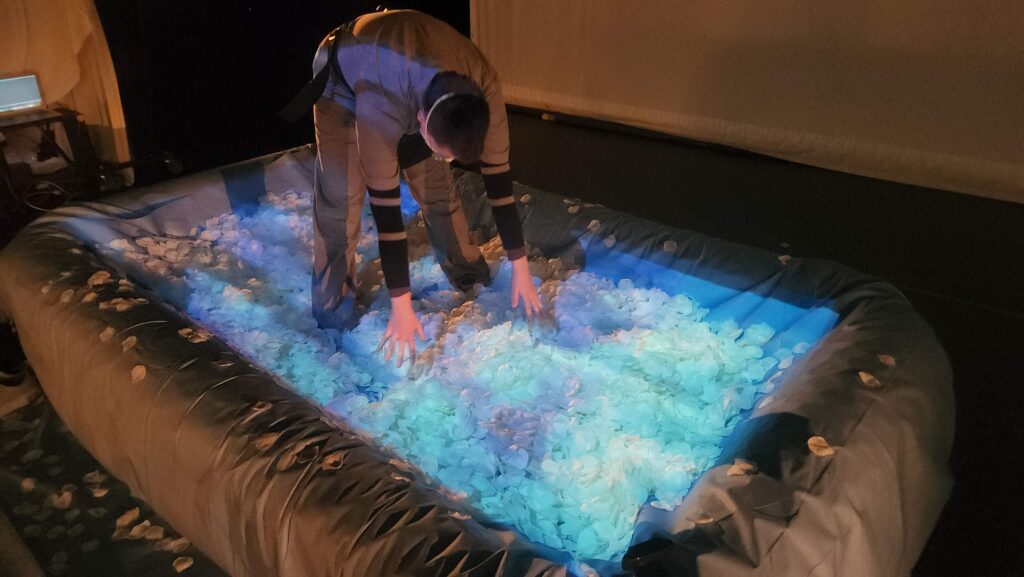
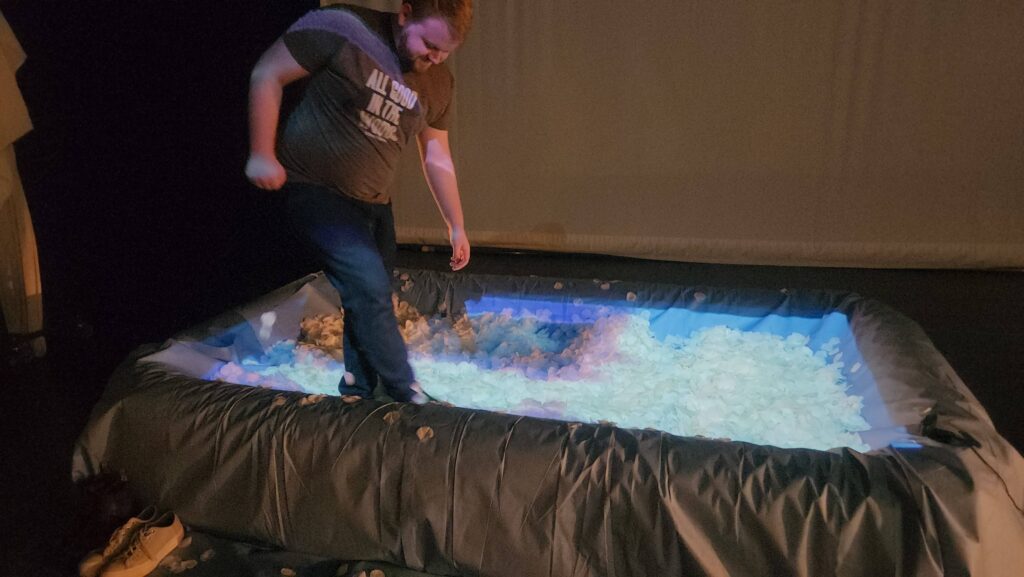
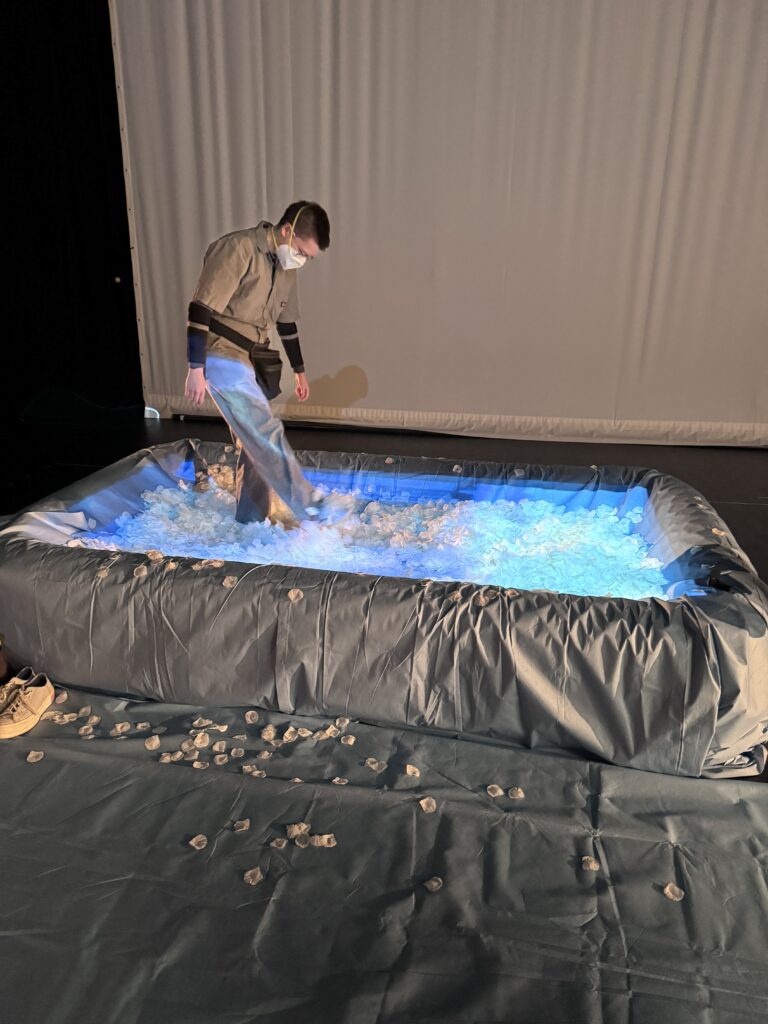
On the day of our class showing, I found that the presence of my installation in the context of other tactile and movement driven exhibits in the Motion Lab helped the handful of context-less visitors figure out how to engage with my space. When people entered the Motion Lab, they first encountered Natasha’s “Xylophone Hero” followed by Amy’s “seance” of voices and lightbulbs. I found that moving through these exhibits established an expectation that people could touch and manipulate my project and encouraged them engage to more fully with my project.
I also observed that the presence of the pool itself and the mat in front of it also encouraged full-body engagement with the project. I watched people “swim” and dance in the petals and describe a desire to lay down or to make snow angels in the petals. The presence of the petals in a physical object that visitors recognized appeared to frame and suggest the possibilities for interacting with the exhibit by making it clear that it was something that they could enter that would support their weight and movement. I also observed that hearing the water sounds in conjunction with my poem also suggested how the participants could interact with my work. Natasha observed that my descriptions of my movement in my poem help her to create her own dance in the pool sprinkling the rose petals and spinning around with them as she would in a pool.
The main hiccup that I observed was that viewers often would not stay very long in the pool once they realized that the petals were clinging to their clothes because of static electricity. This is something that I think I can overcome through the use of static guard or another measure to prevent static electricity from building up on the surface of the petals.
A note about sound…
My intention for this project is for it to serve as a space of quiet meditation through a pleasant sensory experience. However, as a person on the autism spectrum that is easily overwhelmed by a lot of light and noise, I found that I was overwhelmed by my auditory components in conjunction with the auditory components of the three other projects. For the purpose of a group showing, I wish that I had only added the water sound to my project and let viewers take in the sounds from Amy and CG’s works from my exhibit. I ended up severely overstimulated as the day went on and I wonder if this was the impact on other people with similar sensory disorders. This is something that I am taking into consideration as I think about my installation in January.
What would a cycle 4 look like?
I feel incredibly fortunate that this project will get a “cycle 4” as part of my MFA graduation project.
Two of my main considerations for the analog set up at Urban Arts Space are disguising and securing the web camera and creating lighting that will support the project using the gallery’s track system. My plan for hiding the web camera is to tape it to the side of the pool and then wrap it in the drop cloth. This will not make the camera completely invisible to the audience, but it will minimize it’s presence and make it less likely that the web cam could be knocked off or into the pool. As for the lighting, I intend make the back room dim and possibly use amber gels to create a warmer lighting environment to at least get the warmth of theatrical lighting. I may need to obtain floor lamps to get more side light without over brightening the space.
Arcvuken posed the question to me as to how I will communicate how to interact with the exhibit to visitors while I am not present in the gallery. For this, I am going to turn to my experience as neurodivergent person and my experience as an educator of neurodivergent students. I am going to explicitly state that visitors can touch and get into the pool and provide some suggested meditation practices that they can do while in the pool in placards on the walls. Commen sense isn’t common – sometimes it is better for everyone if you just say what you mean and want. I will be placing placards like this throughout the entire gallery for this reason to ensure that visitors – who are generally socialized not to touch anything in a gallery – that they are indeed permitted to physically interact with the space.
To address the overstimulation that I experienced in Motion Lab, I am also going to reduce the auditory components of my installation. I will definitely keep the water sound and play it through a sound shower, as I found that to be soothing. However, I think that I will provide a QR code link to recordings of the poems so that people can choose whether or not they want to listen and have more agency over their sensory experience.
Lawson: Cycle 2
Posted: November 30, 2023 Filed under: Nico Lawson | Tags: Cycle 2, dance, Digital Performance, Interactive Media, Isadora Leave a comment »The poem shared in the videos:
I’m sorry that I can’t be more clear.
I’m still waking up.
This body is still waking up.
What a strange sensation,
To feel a part of you dying while you’re still alive.
What a strange sensation for part of you to feel like someone else.
Maybe she was someone else.
I can’t explain the relief that I feel to let her go.
I can’t explain the peace that I feel,
To give myself back to the dust,
On my own terms this time.
That’s just it.
My past life, Wisteria’s life, is dust.
That life caught fire and returned to the durst from which it came…
But the rain came just as it always does
Cleansing tears and eternal life cycle.
It reminds me that this body is seventy percent water
Intimately tied to planer just the same
That will always come to claim it’s own.
Wash me away and birth me again.
When I still prayed to a god they taught me about baptism.
How the water washes away your sin.
How you die when they lay you down.
How you are reborn when they raise you up.
While Wisteria turns to dust,
I return myself to the water, still on my own terms.
I watch my life in the sunlight that dances on the surface
Let the current take her remains as my tears and the Earth’s flow by.
Grieving…
Lost time
Self-loathing
The beautiful possibilities choked off before they could take root
The parts of myself that I sacrificed in the name of redemption.
And the water whispers love.
I am not sin.
I am holy.
I am sacred.
I am made of the stuff of the Earth and the universe.
No forgiveness, no redemption is necessary.
Only the washing away of the remains of the beautiful mask I wore.
Only the washing away of self-destruction and prayers for mercy.
And when I emerge I hope the water in my veins will whisper love to me
Until I can believe it in every cell…
Technical Elements
Unfortunately I do not have images of my Isadora patch for Cycle 2. I will share more extensive images in my Cycle 3 post. The changes applied to the patch are as follows:
- Projection mapping onto a square the size of the kiddie pool that I will eventually be using.
- Rotating the projection map of the “reflection” to match the perspective of the viewer.
- Adding an “Inside Range” actor to calculate the brightness of the reflection.
- Colorizer and HSL adjust actors to modify the reflection.
For Cycle 2, I also projected onto the silk rose petals that will form the bulk of the future projection surface and set the side lighting to be optimal for not blinding the camera. Before the final showing on December 8, I need to spray the rose petals with starch to prevent them from sticking to each other and participants’ clothing.
For Cycle 3, I know that I will need to remap the projections once the pool is in place. One of the things that I observed from my video is that the water animation and the reflection do not overlap well. Once I have the kiddie pool in place, it will be easier to make sure that the projections fall int he correct place.
I also want to experiment with doubling and layering the projection to play into the already other-worldliness of the digital “water.” I may also play with the colorization of the reflections as well. The reflection image is already distorted; however, it is incredibly subtle and, as noted by one of the viewers at my showing, potentially easy to miss. Since there is no way to make the reflection behave like water, I see no reason not to further abstract this component of the project to make it more easily observable and more impactful on the viewer.
Reflections and Questions
One of my main questions about this part of the project was how to encourage people to eventually get into the pool to have their own experience in the water. For my showing, I verbally encouraged people to get in and play with the flower petals while they listened to me read the poem. However, when this project is installed in exhibition for my MFA project, I will not be present to explain to viewers how to participate. So I am curious about how to docent my project so that viewers want to engage with it.
What I observed during my showing and learned from post-showing feedback is that hearing me read the poem while they were in the pool created an embodied experience. Hearing my perspective on the spiritual nature of my project directed people into a meditative or trance-like experience of my project. What I want to try for Cycle 3 is creating a loop of sections of my poem with prompts and invitations for physical reflections in the pool. My hope is that hearing these invitations will encourage people to engage with the installation. I will also provide written instructions alongside the pool to make it clear that they are invited to physically engage with the installation.
Cycle 1 Reflection Post
Posted: November 2, 2017 Filed under: Bita Bell | Tags: Contemporary Dance, Digital Performance, Interactive Media Leave a comment »For my DEMS final project, I am working on recreating an improvisation that happened in december 2017 in Tehran at the apartment of Iranian female painter, Oldooz. On that day, I was improvising with sensations, textures, colors, lines, and moods of her large painting series called Loneliness. In this project, I am interested in translating my movement investigation with the painting into an interactive installation in which the audience explores different aspects of the painting. I am also researching my memory of that improvisation as well as using photographs as a source to choreograph a solo.
Photographs taken by Oldooz, December 2017, Tehran, Iran.
Cycle 1 deadline pressured me to choose my setting for projection and performance. I decided to use the ceiling projector, projecting to a transparent white cloth screen in dimensions close to the actual real life painting.




